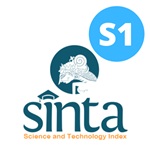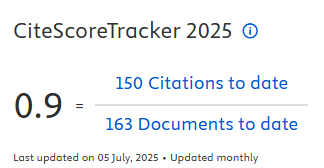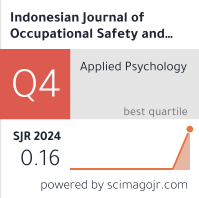Relationship between Work Climate and Physical Workload with Work-Related Fatigue
Downloads
Introduction: Work-related fatigue is a common problem in the workplace that must be solved because it has an impact on the occurrence of workplace accidents, reduces productivity and affects workers' health. A survey conducted by the National Safety Council on 2010 workers in 2017 stated that 69% of them experienced work-related fatigue and 13% of them could be attributed to workplace accidents. Other studies conducted by O'Neill and Panuwatwanich in 2013 stated the loss that could arise due to work-related fatigue is averaged around $ 1,000/week. The purpose of this study was to determine the relationship between work climate and physical workload with work-related fatigue on workers in the 5th warehouse of fabrication area of Bangun Sarana Baja Company. Metods: This study is an observational analytic with a cross-sectional approach with 30 respondents who were randomly selected using the simple random sampling method. Measurements of the work climate used heat stress apparatus by calculating the Wet Bulb Globe Temperature, and measurement of physical workload is carried out by observations referring to Indonesian national standard No. 7269 in 2009. Meanwhile, work-related fatigue is measured objectively by using reaction timer. Results: This study indicates the average work climate is exceeding TLV (28.4° C), and the majority of workers got a moderate physical workload (53.3%) and experience mild work-related fatigue (50%). Conclusion: There was no relation between work climate and work-related fatigue (p-value = 0.192) and there was a significant relationship between physical workload and work-related fatigue (p-value = 0.028, r = 0.400).
Keywords: physcal workload, work climate, work-related fatigue
Adi, D. P. G. S., Suwondo, A. and Lestyanto, D. (2013) ‘The Correlation between Working Climate and Nutrient Intake before Working on the Fatigue Level of the Morning Shift Workers on Packing Division of PT.X, Kendal', Jurnal Kesehatan Masyarakat FKM Undip, 2(2), pp. 1–11.
Ahmad, S. and Amanatun, A. (2015) ‘The Workload with Fatigue Work in Industrial Workers Melinjo Chips in the Village of Benda Indramayu', Jurnal Kesehatan Masyarakat AFIASI, 1(3), pp. 25–30.
Anna, D. H. (2011) ‘The Occupational Environment - Its Evaluation, Control, and Management', in 3rd Edition. Virginia: AIHA.
Herusasongko, B., Sutomo, A. H. and Sudibyakto, H. (2012) ‘Effects of the Occupational Physical Environmental Conditions and the Individual Characteristics of the Workers on Occupational Stress and Fatigue', International Journal of Public Health Science, 1(2), pp. 61–68.
Ho, J. C. et al. (2013) ‘Work-Related Fatigue among Medical Personnel in Taiwan', Journal of the Formosan Medical Association, 112(10), pp. 608–615.
Jacklitsch, B. et al. (2016) ‘Criteria for a Recommended Standard: Occupational Exposure to Heat and Hot Environments'. Ohio: Department of Health and Human Services, Centers for Disease Control and Prevention, National Institute for Occupational Safety and Health.
Krisanti, R. D. (2011) Relation between Pressure Heat with Work Fatigue on Worker Production Section in CV Rakabu Furniture Surakarta. Surakarta: Faculty of Medicine, Universitas Sebelas Maret.
Lemeshow, S. et al. (1997) Adequacy of Sample Size in Health Studies. Edited by P. Dibyo. Yogjakarta: Gajah Mada University Press.
Lumintang, M. F., Kawatu, P. A. T. and Warouw, F. (2017) ‘Relationship between Age and Workload with Work Exhaustion of Workshop Mechanic in Kiawa Raya Village, North Kawangkoan District, Minahasa regency', Jurnal Universitas Sam Ratulangi Manado, 9(3), pp. 1–9.
Marif, A. (2013) Factors Associated with Fatigue on Construction Workers Offshore Pipeline and Mooring Tower (EPC3) in Banyu Urip Project, PT Rekayasa Industri, Serang-Banten 2013. Undergraduate Thesis. Jakarta: Faculty of Medicine and Health Science, Universitas Islam Negeri Syarif Hidayatullah.
Maurits (2010) Glance about Fatigue Work. Yogjakarta: Amara Books.
Meteorology Climatological and Geophysical Agency (2018) Daily Climate Data of Gresik Regency, Jakarta: Meteorology Climatology and Geophysical Agency.
Minister of Manpower of the Republic of Indonesia (2018) Number 5 Year 2018. Concerning Occupational Safety and Health Work Environment. Jakarta: Ministry of Manpower Republic of Indonesia.
Moeljosoedarmo, S. (2008) Higiene Industri. Jakarta: Balai Penerbit FKUI.
National Safety Council (2017) Fatigue in Safety-Critical Industries: Impact, Risks and Recommendations. Washington, DC: National Safety Council.
O'Neill, C. and Panuwatwanich, K. (2013) ‘The Impact of Fatigue on Labour Productivity: Case Study of Dam Construction Project in Queensland', in International Conference on Engineering, Project, and Production Management, pp. 993–1005.
Ricci, J. A. et al. (2007) ‘Fatigue in the U.S. Workforce: Prevalence and Implications for Lost Productive Work Time', Journal of Occupational and Environmental Medicine, 49(1), pp. 1–10.
Ristiyanto, F. (2009) Relationship between Heat Climate Exposure to Work Overview after Working in the Boiler Unit PT. Tiga Pilar Sejahtera Food, Tbk Sepat, Masaran, Sragen, Jawa Tengah. Undergraduate Thesis. Surakarta: Faculty of Medicine, Universitas Sebelas Maret.
Safe Work Australia (2013) Guide for Managing the Risk of Fatigue at Work. Australia: Safe Work Australia.
Setyowati, D. L., Shaluhiyah, Z. and Widjasen, B. (2014) ‘Factors Caused Fatigue among Furniture Workers', Jurnal Kesehatan Masyarakat Nasional, 8(8), pp. 386–392.
Statistic Indonesia (2016) Indonesian Economic Growth in 2015. Jakarta: Statistic Indonesia.
Suma'mur (2013) Corporate Hygiene and Occupational Health (Hiperkes). Edisi 2. Jakarta: Sagung Seto.
Tarwaka (2013) Industrial Ergonomics: Basics of Ergonomics Knowledge and Applications at Work. Surakarta: Harapan Press.
Tarwaka, Bakri, S. H. A. and Sudiajeng, L. (2004) Ergonomics for Safety, Occupational Health and Productivity. 1st edn. Surakarta: UNIBA Press.

In order to be accepted and published by The Indonesian Journal of Occupational Safety and Health, Author(s) who submit an article should complete all the review process. The copyright of received articles assigned to the The Indonesian Journal of Occupational Safety and Health and Department of Safety and Health, Universitas Airlangga as publishers of the journal. The intended copyright includes the rights to publish articles in various forms (including reprints).
The Editorial Team of The Indonesian Journal Of Occupational Safety and Health and Department of Safety and Health strive to ensure that no errors occur in the articles that have been published, both data errors and statements in the article.
Users of this website will be licensed to use materials from this website following the Creative Commons Attribution-NonCommercial-ShareAlike 4.0 International License. No fees charged. Please use the materials accordingly.
------------------------------------------------------------------------------------------------------------------------------------------------------------------------------------------
Attribution ” You must give appropriate credit, provide a link to the license, and indicate if changes were made. You may do so in any reasonable manner, but not in any way that suggests the licensor endorses you or your use.
NonCommercial ” You may not use the material for commercial purposes.
ShareAlike ” If you remix, transform, or build upon the material, you must distribute your contributions under the same license as the original.







 How to Submit Articles in OJS
How to Submit Articles in OJS

























